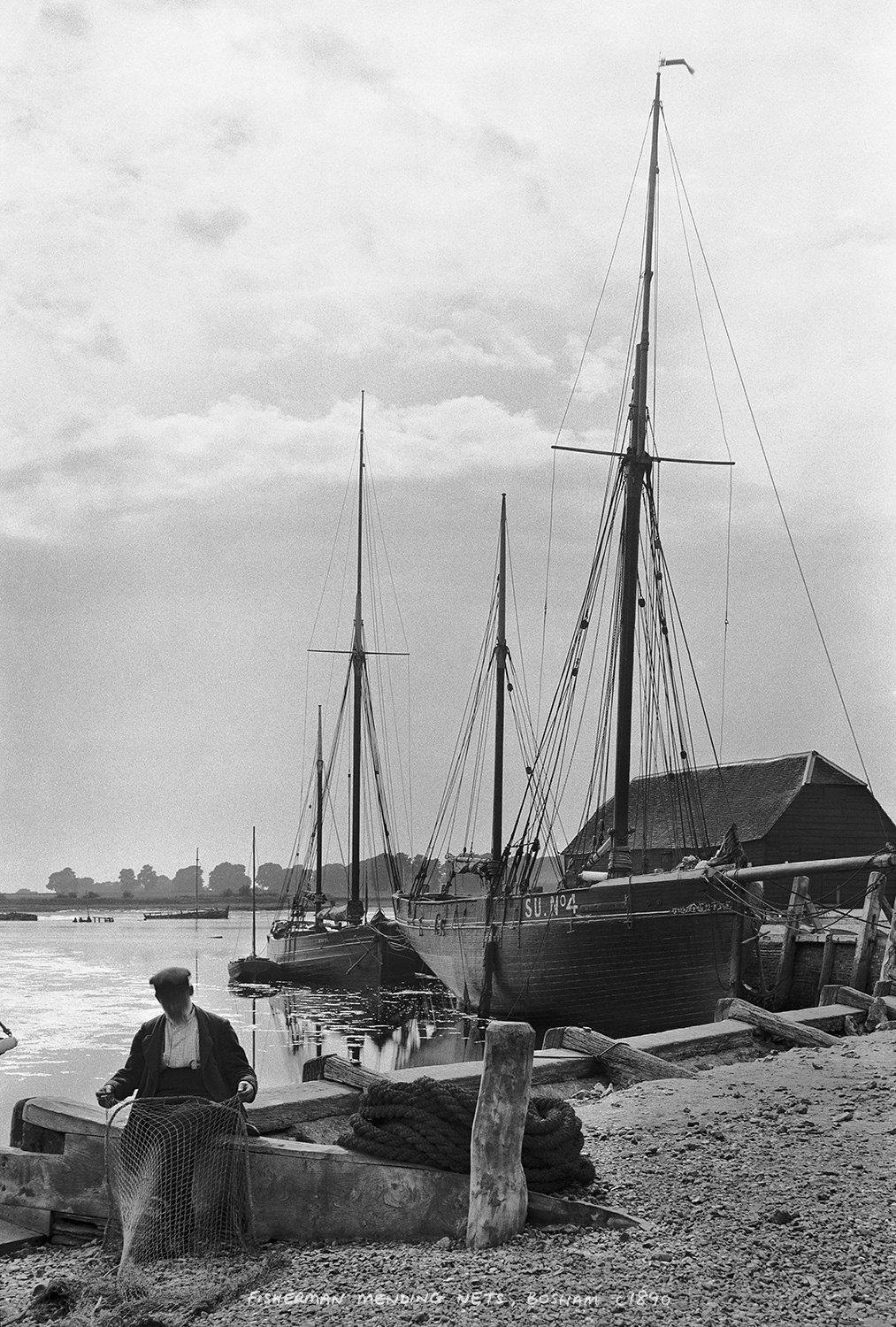
Throughout its two-thousand-year history, Bosham has always been predominantly a fishing village. In the second half of the nineteenth century, Bosham's fishing fleet thrived as they took advantage of the arrival of the London, Brighton and South Coast Railway in 1846, and the opportunity to expand their markets. Before then, fish landed on Bosham Quay was sold only locally - to locals as well as in Chichester and the surrounding villages. When fish supplies were plentiful, the villagers salted down their surplus for use in winter months.
In 1817, Bosham's fishing fleet had 25 boats. Mackerel, shrimp, and cockles were in plentiful supply in Chichester Harbour. In the English Channel herring, mullet, crab and bass could be fished with ease. Bosham's fishermen dredged for young oysters mostly in the shallow waters of the English Channel and off the French coast, as the harbour's native oyster beds had been fished to extinction. Along with Emsworth's fishermen, Bosham's fishing fleet established an oyster fishery which practised an early form of factory farm fishing, with nursery beds at Rookwood, West Wittering and oyster ponds all along the foreshore of Bosham's two creeks, either side of Bosham Quay, which they rented from the Lord of The Manor of Bosham for 2s 6d (half a Crown) each per year in rent.
Bosham's fishermen dredged for scallops as well as oysters. Oysters do not thrive in deep water, below 25 feet, because the light cannot filter down to them. However, scallops can only thrive below 25 feet, and therefore they complement one another. The fishermen dredged for oysters in shallow waters near the coastline, and as they sailed further out into the English Channel, they dredged in deeper waters collecting scallops. They fished for mussels near Shoreham, and some of the larger fishing boats fished for cod, a deep-sea fish found in the North Sea.
The arrival of the railways had a very beneficial effect on Bosham's fishing industry because it opened up new markets, and allowed the fishermen to get their catch to market much more quickly. Fish landed on Bosham Quay could now be sent to Bosham's railway station by horse and cart, and reach London on the same day.
Bosham's boatbuilders began to build bigger fishing boats that could stay at sea longer, and hold larger cargoes of fish, and by the late nineteenth century when this photograph was made, forty fishing boats worked from Bosham. Ned Combes owned one of the biggest fishing boats in the harbour, which was thirty feet long. The fishing boats would typically be away for four or five days at a time, and as well as selling fish at Bosham Quay they would land their catches daily in either Portsmouth or Southampton. By then they fished far and wide, regularly in the North Sea, and all along the English Channel as far as Falmouth, and the north coast of France, particularly near Brittany.
Back in port, the fishermen used the old barn on the Quay, known as the Raptackle, to store and mend fishing nets, as well as packing oysters. The fishermen lived in the terrace of houses along the shore and in the cottages of the High Street.
The life of a fisherman was hard, because they had to be able to respond to the changing tides, and be out on the water in all conditions. Even within the harbour itself the weather could be threatening, and boats that ventured out of the sheltered harbour in bad weather would have had a very difficult time. They had no navigation equipment, mechanical power or safety equipment; if they got into difficulties, they had to get themselves out of it, and it wasn't uncommon to lose a ship and all hands at sea. For example, Thistle from Emsworth's fishing fleet registered in 1889, was lost with all hands in the same year on her way back from the North Sea oyster beds. Any loss would have been felt throughout the harbour's fishing fleets, which was a tight-knit community.
Fishing could be very profitable and Bosham's fishermen built up considerable wealth during the second half of the nineteenth century, particularly during the boom for oysters which peaked in the 1890s. Members of the fishing fleets were paid in shares of the catch. The fishermen were well-respected members of the village community, particularly the oyster dredgermen who were considered the craftsmen of the fishing fleet.
During the summer months, the harbour's fishing fleets raced in regattas organised by the customs house, as well as crewing in the big yachts racing in the Solent. Fishing would have been predominantly a winter activity. When yachting became an occupation of the rich in the late 1800s the fishermen crewed in famous yachts such as the Sir Thomas Lipton, Shamrock and Britannia in the summer months, and spent the winter months fishing in Bosham.
For most fishermen, fishing was probably only a part of what they did. Bosham was also a busy port for the transport of coastal freight, and the fishermen worked loading and unloading the trading ketches and schooners when they weren't fishing. By 1880, most incoming trade at Bosham Quay was coal which came from the east coast, mostly from Newcastle.
© Luke Whitaker
Click HERE to buy print